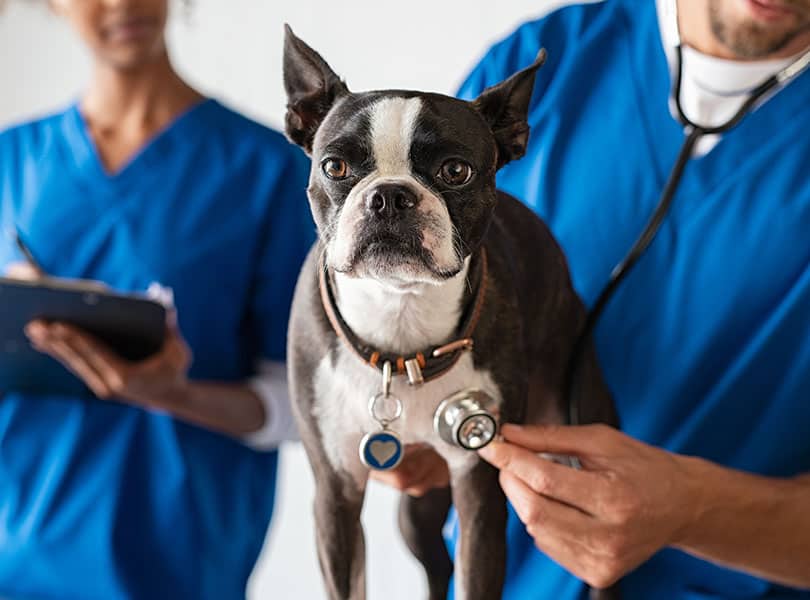The Function of Ultrasound and CT Check in Modern Vet Practices: Insights From Experienced Professionals
In contemporary vet techniques, ultrasound and CT scans greatly enhance analysis capacities. These imaging techniques give essential insights into animal health and wellness, directing treatment decisions. Experienced professionals acknowledge the special advantages of each method. Ultrasound uses real-time assessments, while CT scans supply elaborate anatomical information. Understanding their applications and functions increases important concerns regarding their effect on person outcomes and the future of veterinary diagnostics. What understandings can be gained from their incorporated usage?
Comprehending Ultrasound in Veterinary Medication
Ultrasound is a crucial diagnostic tool in veterinary medicine, offering a non-invasive method to visualize inner frameworks. This imaging method uses high-frequency audio waves to create real-time pictures of cells and organs, allowing vets to examine conditions without medical treatment. Usual applications include assessing the heart, liver, kidneys, and reproductive body organs, along with monitoring pregnancies.The treatment is reasonably fast and can be performed in various settings, making it an easily accessible alternative for vets. Unlike radiography, ultrasound provides comprehensive info concerning soft cells and blood flow, which is essential for precise diagnoses.Veterinary professionals count on ultrasound to find irregularities such as growths, cysts, and liquid accumulation. Its ability to guide biopsies and other procedures additionally enhances its utility in clinical practice. By offering a safe and reliable means to analyze interior composition, ultrasound has come to be a foundation of modern veterinary diagnostics.
The Benefits of CT Scans for Pet Diagnostics
CT checks deal substantial benefits in veterinary diagnostics by supplying boosted accuracy in determining inner problems (Cancer Veterinary Near Me). As a non-invasive imaging strategy, they assure the safety and security and convenience of animals throughout examinations. In addition, CT scans assist in a thorough evaluation of interior frameworks, enabling a lot more effective treatment preparation
Boosted Diagnostic Accuracy
Innovations in imaging technology have considerably boosted analysis accuracy in vet medicine, specifically through making use of CT scans. These scans supply comprehensive cross-sectional pictures of an animal's internal frameworks, enabling vets to determine irregularities with precision. The high resolution and three-dimensional capabilities of CT imaging promote the detection of conditions such as tumors, cracks, and internal bleeding that could be missed out on with typical imaging methods. Additionally, CT scans can help in pre-surgical planning by providing a comprehensive sight of anatomical partnerships. This degree of detail not only improves the accuracy of diagnoses yet also help in tailoring reliable therapy strategies. The combination of CT modern technology right into vet techniques is changing the landscape of animal healthcare, enhancing results for individuals.
Non-Invasive Imaging Strategy
The introduction of non-invasive imaging methods has actually changed pet diagnostics, with CT checks arising as a noticeable device in vet practices. These scans supply high-resolution, cross-sectional pictures of a pet's inner structures, enabling veterinarians to examine complex conditions without the demand for intrusive procedures. The benefits of CT scans include their capability to find tumors, cracks, and interior bleeding with impressive precision. Additionally, they promote the examination of soft cells and organs, boosting analysis abilities. The rate of CT scanning makes it possible for quick decision-making, which is important in emergency situation situations. By decreasing stress and discomfort for the pet, CT scans add to a much more humane method to diagnostics, eventually enhancing treatment outcomes and advancing veterinary care.
Comprehensive Internal Evaluation
An extensive inner analysis is essential for exact diagnosis and effective treatment in vet medication. CT checks deal considerable advantages hereof, providing comprehensive cross-sectional pictures of an animal's internal frameworks. This innovative imaging modality boosts visualization of intricate physiological regions, enabling vets to recognize abnormalities such as tumors, fractures, and interior blood loss with higher accuracy. Additionally, CT scans promote the assessment of conditions that may be challenging to diagnose with traditional methods. The speed and accuracy of CT imaging also add to prompt treatments, improving patient results. As veterinary practices significantly integrate CT technology, the advantages of considerable inner analyses come to be obvious, enhancing the relevance of this device in contemporary vet diagnostics.
Comparing Ultrasound and CT Imaging Techniques
While both ultrasound and CT imaging offer important duties in vet diagnostics, each method provides unique benefits and restrictions that can influence scientific decision-making. Ultrasound is specifically valued for its real-time imaging capabilities, allowing veterinarians to observe vibrant physical procedures. This strategy is non-invasive, mobile, and does not entail ionizing radiation, making it a safer option for both medical professionals and animals. However, ultrasound may have constraints in envisioning specific physiological frameworks or deep tissues.Conversely, CT imaging gives thorough cross-sectional views of the body, permitting precise localization of abnormalities. It masters examining complicated body organs and structures, especially in the thorax and abdominal area. Nevertheless, CT scans need sedation or anesthesia oftentimes and include direct exposure to ionizing radiation. Ultimately, the selection in between ultrasound and CT depends upon the certain scientific scenario, the location of passion, and the urgency of the diagnostic demands.
Instance Researches: Successful Diagnoses Through Imaging
Study illustrate the significant renovations in analysis accuracy accomplished through sophisticated imaging innovations like ultrasound and CT scans in vet methods. These improvements not just enhance the discovery of numerous conditions however also assist in efficient and timely treatment plans. Evaluating particular instances can highlight the transformative impact of these imaging techniques on vet medicine.
Diagnostic Precision Improvements

Imaging Technology Advancements
As vet imaging modern technology remains to progress, its effect on analysis abilities becomes progressively obvious. Current case research studies highlight the successful application of innovative ultrasound and CT scan methods in recognizing complex problems. A vet center made use of high-resolution CT scans to identify an uncommon kind of lung cancer in a canine, which traditional imaging had actually missed out on. Similarly, an ultrasound assessment revealed an abdominal mass in a cat, triggering prompt surgical treatment and a favorable end result. These innovations not just enhance diagnostic accuracy but also allow vets to create targeted therapy strategies. By leveraging innovative imaging innovations, vet specialists are markedly improving client treatment, leading to much more effective management of numerous wellness problems in pets.
The Duty of Imaging in Emergency Situation Vet Treatment
Imaging plays an essential function in emergency vet treatment, providing veterinarians with vital info Cancer Veterinary Near Me required to make rapid, enlightened choices. In immediate circumstances, techniques like ultrasound and CT scans allow specialists to promptly evaluate a pet dog's interior structures, recognizing crucial conditions such as interior blood loss, cracks, or body organ abnormalities. These imaging methods allow for real-time examinations, assisting in timely interventions that can be life-saving. For instance, ultrasound is vital for reviewing soft tissue injuries and problems like liquid buildup, while CT checks offer thorough photos of complicated anatomical structures, necessary for detecting trauma instances. The rate and accuracy of these imaging strategies improve the vet's capability to create efficient therapy plans, guaranteeing the very best feasible results for their individuals. As a result, the combination of advanced imaging innovations into emergency veterinary practices is not only useful but progressively essential, as it boosts diagnostic capabilities and improves general animal care throughout important moments.
Training and Know-how in Vet Imaging
Although innovative imaging techniques such as ultrasound and CT scans are crucial for effective veterinary treatment, the effective implementation of these modern technologies heavily depends on the training and expertise of veterinary professionals. Efficient usage of imaging devices needs detailed knowledge of anatomy, pathology, and the principles underlying each technique. Vet specialists should undergo specialized training to properly interpret imaging results, which is vital for diagnosing problems and preparing treatment.Certifications and proceeding education and learning in veterinary imaging enhance the skills of experts, enabling them to stay upgraded with technological advancements. Partnership between radiologists and veterinarians often causes boosted analysis accuracy, as specialists can offer understandings right into complicated situations. Additionally, sensible experience in managing imaging devices cultivates confidence in its application. Ultimately, the high quality of veterinary imaging solutions is straight associated to the level of training and expertise possessed by the professionals making use of these necessary analysis tools.
Future Trends in Diagnostic Imaging for Animals
With the quick innovations in innovation, vet analysis imaging is positioned for substantial advancement in the coming years. Arising fads suggest a change in the direction of more obtainable and portable imaging methods, such as handheld ultrasound tools, which could improve area diagnostics. In addition, the combination of man-made knowledge is expected to reinvent photo analysis, permitting quicker and much more precise interpretations of results.Moreover, innovations in 3D imaging strategies and calculated tomography will provide vets with more thorough sights of animal makeup, leading to better treatment strategies. Virtual reality innovation might also play a duty in medical preparation and education, offering veterinarians an unique point of view on intricate cases.As telemedicine continues to expand, remote consultations promoted by diagnostic imaging will become more common, allowing experts to help family doctors in real-time. Overall, these patterns are readied to improve the performance and effectiveness of veterinary care, eventually enhancing animal end results.
Frequently Asked Concerns
Just How Much Do Ultrasound and CT Scans Cost in Vet Facilities?
The prices of ultrasound and CT scans in vet facilities typically vary from $300 to $1,500, relying on variables such as area, clinic type, and certain treatments needed for the animal's diagnosis and therapy.

Exist Any Type Of Threats Related To Ultrasound and CT Checks for Pet Dogs?
Ultrasound and CT scans generally present minimal dangers to animals. Nevertheless, possible concerns include sedation reactions and exposure to anesthetics. Ultrasound For Dogs. Vets carefully analyze each case to reduce any kind of risks connected with these analysis treatments
How Much Time Do Ultrasound and CT Procedures Usually Take?
Ultrasound procedures generally take around thirty minutes to an hour, relying on the intricacy. CT scans, being even more in-depth, usually require thirty minutes to 90 mins, consisting of preparation and recovery time for the pet.
Can All Veterinarians Perform Ultrasounds and CT Scans?
Not all vets can carry out ultrasounds and CT scans. Specialized training and qualification are often required to guarantee proficiency in these advanced imaging techniques, which might restrict their schedule to vets with extra credentials and sources.
What Sorts Of Animals Profit The Majority Of From These Imaging Techniques?
Specific animal species, particularly pet cats and canines, benefit considerably from ultrasound and CT scans. These imaging techniques improve analysis accuracy for problems like growths, interior injuries, and body organ problems, leading to enhanced therapy results and person treatment. The high resolution and three-dimensional capabilities of CT imaging promote the discovery of problems such as tumors, fractures, and interior blood loss that may be missed out on with typical imaging approaches. Situation research studies show the substantial enhancements in analysis precision achieved through innovative imaging modern technologies like ultrasound and CT scans in veterinary techniques. Improving analysis precision in veterinary practices has been considerably helped by developments in imaging modern technologies such as ultrasound and CT scans. Innovative imaging strategies such as ultrasound and CT scans are essential for reliable vet treatment, the effective application of these innovations heavily depends on the training and proficiency of veterinary professionals. Veterinary experts need to undertake specific training to precisely interpret imaging results, which is crucial for diagnosing problems and intending treatment.Certifications and continuing education in veterinary imaging enhance the skills of professionals, enabling them to remain upgraded with technical innovations.